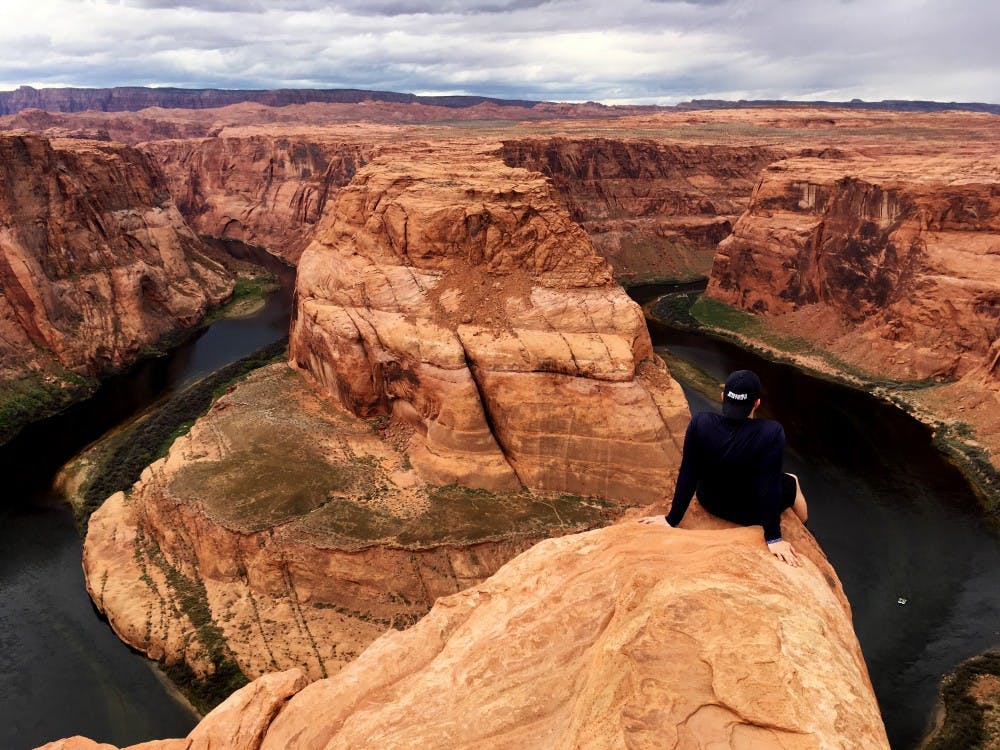U.S. Route 89 in northern Arizona is just like most highways in the American Southwest -- barren, dusty, cutting through a vast desert expanse dotted with pale green shrubs and the occasional cactus. Unlike my hometown north of Boston, where the suburbs fill the map like a geographic jigsaw puzzle, this area is hauntingly unpopulated, the roads stretching for miles in between cities with names like Wahweap and Lechee.
But 20 miles south of the Utah border, in between mileposts 544 and 545, there stands a small brown road sign that reads "Horseshoe Bend" that points down a dirt path to the west. Cars and vans travelling down the path must avoid crisscrossing tumbleweeds before arriving at a large parking lot filled with vehicles sporting license plates from all over the U.S. and Canada.
The hike to Horseshoe Bend is as bland and sandy as the road that leads to the trailhead. Hikers climb for a quarter-mile up a gradual dirt trail before descending for another half-mile. Trudging through the desert, it's difficult to not wonder where the hell you are -- the flat, desolate landscape extends for miles in every direction, with mesas and mountains lining the horizon in the distance.
But then, something spectacular happens.
As you near the end of the trail, the Bend slowly reveals itself. What once seemed like a continuation of the desert floor drops away, revealing a U-shaped canyon plummeting 1,000 feet below. Standing at the rim, you can spot rafters and kayakers below, tiny specks on the Colorado River, which has been carving this meandering chasm out of the rock for millions of years. It's a massive, hidden marvel, an oasis of beauty amid an otherwise empty landscape.
I sit on the rock and dangle my feet over the edge, nervously aware of the emptiness beneath my toes. One wrong movement, one erroneous weight shift would result in a horrid tumble into the canyon below, but yet I can't pull myself away. There's something delightfully humbling about balancing on the rim, touching the void, inching as close as I can toward the massive, natural splendor surrounding me.
Eager to share this image with my friends and family back home, I pull my phone out of my pocket (extremely carefully) and start snapping photos, attempting different angles and styles, doing everything I can to capture the magnificence of the moment.
But nothing works.
No matter what setting I use, no matter how far I push my luck leaning over the lip of the canyon, there's something missing from the photos. Each one looks great, but they're simply not depicting the sheer vastness of this natural pit. Maybe it's my phone's inability to capture depth, or maybe it's because I have the photography skills of a 3-year-old with a Kodak, but the pictures fail to represent how deep, how colossal this hole in the ground truly is.
But there's more to it than that. The thrill of this landmark isn't solely visual. The photos can capture how gorgeous it is, but they can't reveal the wonder of walking down the trail and watching the desert floor disappear. They can't convey the exhilaration of standing at the edge of the abyss as the wind whips around you.
I close my eyes and think of the explorers who travelled here centuries ago, the adventurers who braved the barren desert, waiting for the moment the landscape would give way to such profound beauty. It was a different time, an era when maps had final edges, daring people to venture into the unknown.
There might not be as much uncharted territory today, but visiting Horseshoe Bend, I can still feel that same sense of discovery.
Enjoy what you're reading?
Signup for our newsletter
I put my phone carefully back in my pocket, and I open my eyes.




